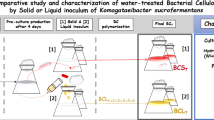Abstract
The assembly of cellulose microfibrils was investigated in artificially induced protoplasts of the alga, Valonia macrophysa (Siphonocladales). Primary-wall microfibrills, formed within 72 h of protoplast induction, are randomly oriented. Secondary-wall lamellae, which are produced within 96 h after protoplast induction, have more than three orientations of highly ordered microfibrils. The innermost, recently deposited micofibrils are not parallel with the cortical microtubules, thus indicating a more indirect role of microtubules in the orientation of microfibrils. Fine filamentous structures with a periodicity of 5.0–5.5 nm and the dimensions of actin were observed adjacent to the plasma membrane. Linear cellulose-terminal synthesizing complexes (TCs) consisting of three rows, each with 30–40 particles, were observed not only on the E fracture (EF) but also on P fracture (PF) faces of the plasma membrane. The TC appears to span both faces of the bimolecular leaflet. The average length of the TC is 350 nm, and the number of TCs per unit area during primary-wall synthesis is 1 per μm2. Neither paired TCs nor granule bands characteristic of Oocystis were observed. Changes in TC structure and distribution during the conversion from primary- to secondary-wall formation have been described. Cellulose microfibril assembly in Valonia is discussed in relation to the process among other eukaryotic systems.
Similar content being viewed by others
Abbreviations
- TC:
-
terminal complex
- EF:
-
E (outer leaflet) fracture face of the plasma membrane
- PF:
-
P (inner leaflet) fracture face of the plasma membrane
- MT:
-
microtubule
- PS:
-
protoplasmic surface of the membrane
References
Allen, N.S. (1980) Cytoplasmic streaming and transport in the characean alga Nitella. Can. J. Bot. 58, 786–796
Brown, R.M., Jr., Franke, W.W., Klenig, H., Falk, H., Sitte, P. (1970) Scale formation in Chrysophycean Algae I. Cellulosic and noncellulosic wall components made by the Golgi apparatus. J. Cell Biol. 45, 246–271
Brown, R.M., Jr., Montezinos, D. (1976) Cellulose microfibrils: visualization of biosynthetic and orienting complexes in association with the plasma membrane. Proc. Natl. Acad. Sci. USA 73, 143–147
Chihara, M. (1959) Studies on the life-history of the green algae in the warm seas around Japan (9) Supplementary note on the life-history of Valonia macrophysa Kütz. J. Jpn. Bot. 34, 1–11
Enomoto, S., Hirose, H. (1972) Culture studies on artificially induced aplanospores and their development in the marine alga Boergesenia forbesii (Harvey) Feldmann (Chlorophyceae, Siphonocladales). Phycologia 11, 119–122
Gardner, K.H., Blackwell, J. (1974) The structure of native cellulose. Biopolymers 13, 1975–2001
Giddings, T.H., Jr., Brower, D.L., Staehelin, A. (1980) Visualization of particle complexes in the plasma membrane of Micrasterias denticulata associated with the formation of cellulose fibrils in primary and secondary cell walls. J. Cell Biol. 84, 327–339
Goto, T., Harada, H., Saiki, H. (1978) Fine structure of cellulose microfibrils in poplar gelatinous layer and Valonia. Wood Sci. Technol. 12, 223–231
Heuser, J.E., Kirschner, M.W. (1980) Filament organization revealed in platinum replicas of freeze-dried cytoskeletons. J. Cell Biol. 86, 212–234
Itoh, T., O'Neil, R., Brown, R.M., Jr. (1984) Interference of cell wall regeneration of Boergesenia forbesii protoplasts by Tinopal LPW, a fluorescent brightening agent. Protoplasma (in press)
Mitzuta, S., Wada, S. (1981) Microfibrillar structure of growing cell wall in a coenocytic green alga, Boergesenia forbesii. Bot. Mag. 94, 343–353
Montezinos, D. (1982) A cytological model of cellulose biogenesis in the alga Oocystis apiculata. In: Cellulose and other natural polymer systems, pp. 3–21, Brown, R.M., Jr., ed. Plenum Press, New York
Mueller, S.C., Brown, R.M., Jr. (1980) Evidence for an intramembrane component associated with a cellulose microfibril-synthesizing complex in higher plants. J. Cell Biol. 84, 315–326
Mueller, S.C., Brown, R.M., Jr. (1982a) The control of cellulose microfibril deposition in the cell wall of higher plants. I. Can directed membrane flow orient cellulose microfibrils? Indirect evidence from freeze-fractured plasma membranes of maize and pine seedling. Planta 154, 489–500
Mueller, S.C., Brown, R.M., Jr. (1982b) The control of cellulose microfibril deposition in the cell wall of higher plants. II. Freeze-fracture microfibril patterns in maize seedling tissues following experimental alteration with colchicine and ethylene. Planta 154, 501–515
Mueller, S.C., Brown, R.M., Jr., Scott, T.K. (1976) Cellulosic microfibrils: nascent stages of synthesis in a higher plant cell. Science 194, 949–951
Preston, R.D. (1964) The physical biology of plant cell walls. Chapman & Hall, London
Preston, R.D., Kuyper, B. (1951) Electron microscopic investigations of the walls of green algae. I. A preliminary account of wall lamellation and deposition in Valonia ventricosa J. Exp. Bot. 2, 247–256
Preston, R.D., Nicolai, E., Kuyper, B. (1953) Electron microscopic investigations of the walls of green algae. II. The cytoplasm-wall relationship in freeze-dried Valonia macrophysa. J. Exp. Bot. 4, 40–43
Quader, H., Robinson, D.G. (1981) Oocystis solitaria: a model organism for understanding the organization of cellulose synthesis. Ber. Dtsch. Bot. Ges. 94, 75–84
Robinson, D.G., Preston, R.D. (1972) Plasmalemma structure in relation to microfibril biosynthesis in Oocystis. Planta 104, 234–246
Robinson, D.G., Quader, H. (1981) Structure, synthesis, and orientation of microfibrils. IX. A freeze-fracture investigation of the Oocystis plasma membrane after inhibitor treatments. Eur. J. Cell Biol. 25, 278–288
Sarko, A., Muggli, R. (1974) Packing analysis of carbohydrates and polysaccharides. IV. Valonia cellulose and cellulose II. Macromolecules 7, 486–494
Schnepf, E., Deichgräber, G., Herth, W. (1982) Development of cell wall appendages in Acanthosphaera zachariasi (Chlorococcales): kinetics, site of cellulose synthesis and of microfibril assembly, and barb formation. Protoplasma 110, 203–214
Steward, F.C., Mühlethaler, K. (1953) The structure and development of cell-wall in the Valoniaceae as revealed by the electron microscope. Ann. Bot. (London) 17, 295–315
Willison, J.H.M., Brown, R.M., Jr. (1977) An examination of the developing cotton fiber: wall and plasmalemma. Protoplasma 92, 21–41
Willison, J.H.M., Brown, R.M., Jr. (1978) Cell wall structure and deposition in Glaucocystis. J. Cell Biol. 77, 103–119
Author information
Authors and Affiliations
Rights and permissions
About this article
Cite this article
Itoh, T., Brown, R.M. The assembly of cellulose microfibrils in Valonia macrophysa Kütz. Planta 160, 372–381 (1984). https://doi.org/10.1007/BF00393419
Received:
Accepted:
Issue Date:
DOI: https://doi.org/10.1007/BF00393419




